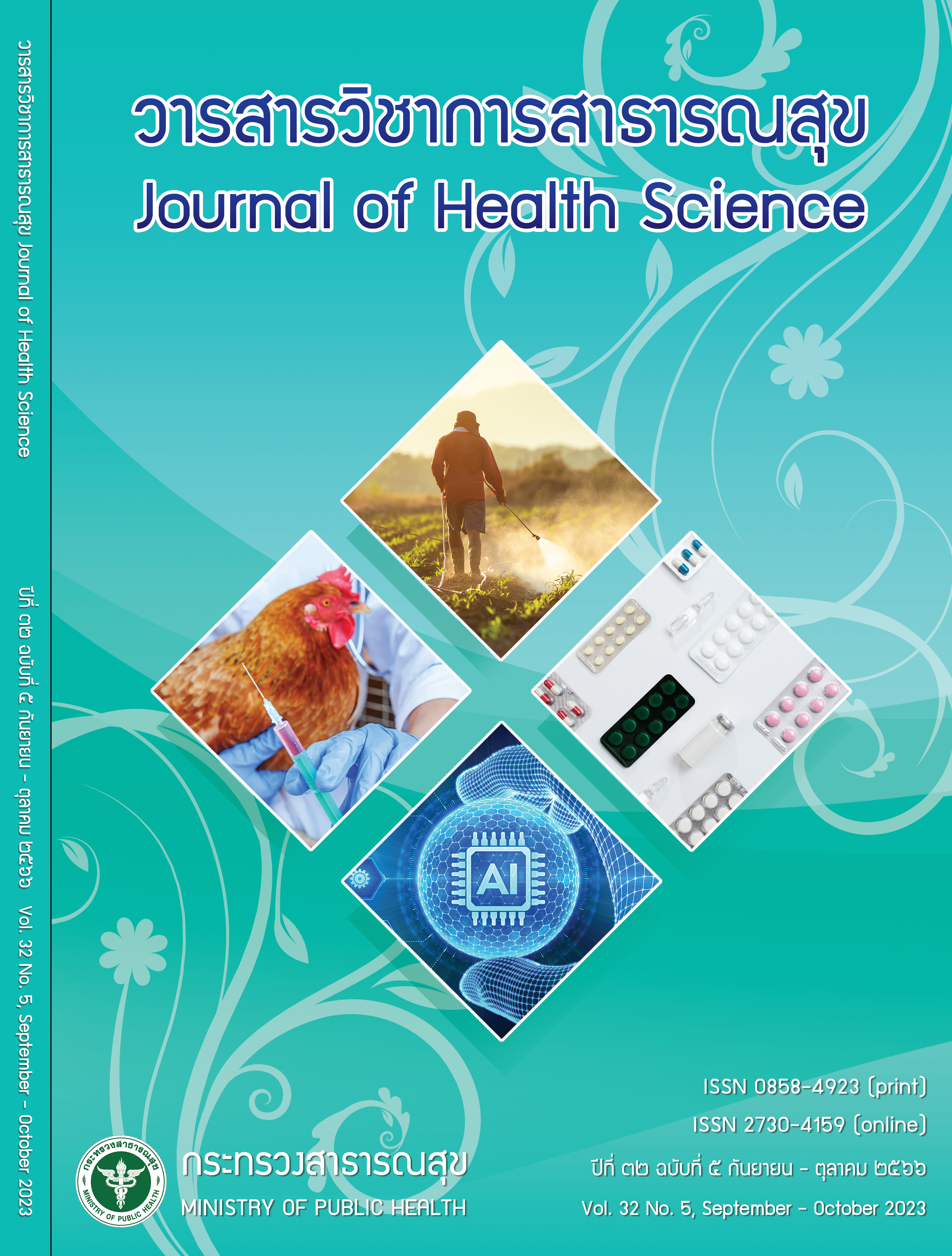ความสมเหตุสมผลในการให้ยาปฏิชีวนะเพื่อป้องกันการติดเชื้อในทางเดินปัสสาวะสำหรับผู้ป่วยเข้ารับการส่องตรวจท่อปัสสาวะด้วยกล้องชนิดแข็ง: การศึกษา แบบสุ่ม ในกลุ่มอาสาสมัครควบคุม
คำสำคัญ:
การติดเชื้อทางเดินปัสสาวะ, การส่องกล้องตรวจท่อปัสสาวะ, ยาปฏิชีวนะ, ป้องกัน, การศึกษาเปรียบเทียบ, การใช้ยาอย่างสมเหตุผลบทคัดย่อ
การศึกษานี้เปรียบเทียบผลการติดเชื้อในทางเดินปัสสาวะในผู้ป่ วยที่เข้ารับการส่องตรวจท่อปัสสาวะด้วยกล้องส่องชนิดแข็งระหว่างกลุ่มที่ได้รับยาปฏิชีวนะและกลุ่มที่ได้ยาหลอกเพื่อเป็น แนวทางในการใช้ยาอย่างสมเหตุสมผล ผู้ศึกษาได้คัดเลือกอาสาสมัครอายุ 18 ปีขึ้นไปที่เข้ารับการ ส่องตรวจท่อปัสสาวะด้วยกล้องส่องชนิดแข็งซึ่งไม่มีภาวะติดเชื้อ ในทางเดินปัสสาวะ นำมาก่อนใน ช่วงระหว่างปีพ.ศ. 2558 - พ.ศ. 2559 จำนวนทั้งสิ้น 66 ราย โดยสุ่มเลือกโดยใช้ตารางสุ่ม เพื่อ แยกอาสาสมัคร เป็นสองกลุ่ม ได้แก่ กลุ่มที่ได้ยาปฏิชีวนะ Ofloxacin 200 mg. และกลุ่มที่ได้ยาหลอก ก่อนทำการ ส่องตรวจประเมินผลการติดเชื้อในทางเดินปัสสาวะโดยการเพาะเชื้อแบคทีเรียในปัสสาวะ และอาการไข้ที่เกิดจากการติดเชื้อ ในทางเดินปัสสาวะ การคำนวณทางสถิติใช้ independent samples t-test และ Fisher’s exact test โดยให้ค่าความเชื่อมั่น p<0.05 ในการยืนยันความแตกต่างอย่างมี นัยสำคัญ ผลการศึกษาพบว่ากลุ่มอาสาสมัครทั้งสองกลุ่ม ที่ได้จากการสุ่ม ไม่มีความแตกต่างด้าน demographic data เมื่อวิเคราะห์ผลการติดเชื้อในทางเดินปัสสาวะ ไม่พบความแตกต่างอย่างมีนัย สำคัญทางสถิติ ทั้งนี้ไม่พบภาวะไม่พึงประสงค์ในอาสาสมัครที่เข้าร่วมการวิจัยนี้ ในการวิจัยนี้ให้ผล ที่สะท้อนว่าการให้ยาปฏิชีวนะแก่ผู้ป่ วย ที่เข้ารับการส่องตรวจท่อปัสสาวะด้วยกล้องส่องชนิดแข็ง ไม่มีความจำเป็น สนับสนุนการใช้ยาอย่างสมเหตุผลที่ไม่ต้องให้ยาปฏิชีวนะก่อนเข้ารับการตรวจ ทั้งนี้ อาจจำเป็นต้องทำการวิจัยในกลุ่มตัวอย่างที่เพิ่มขึ้นเพื่อให้มั่นใจในผลที่ได้ต่อไป
Downloads
เอกสารอ้างอิง
Almallah YZ, Rennie CD, Stone J, Lancashire MJR. Urinary tract infection and patient satisfaction after flexible cystoscopy and urodynamic evaluation. Urology 2000;56(1):37-9.
Escandón-Vargas K, García-Perdomo HA, Echeverría F, Osorio JD. Risk of urinary tract infection in patients with positive urine culture and antibiotic therapy undergoing cystoscopy in a third-level hospital. Infezioni in Medicina 2015;23(4):336-42.
Clark KR, Higgs MJ. Urinary infection following out-patient flexible cystoscopy. British Journal of Urology 1990;66(5):503-5.
Ordon M, Kodama R, Honey RJ. Letter to the Editor re best practice policy statement on urologic surgery antimicrobial prophylaxis (Wolf Jr JS, Bennett CJ, Dmochowski RR, Hollenbeck BK, Pearle MS, Schaeffer AJ). J Urol 2009:182(2):799-801.
Nicolle LE, Bradley S, Colgan R, Rice JC, Schaeffer A, Hooton TM. Infectious diseases society of America guidelines for the diagnosis and treatment of asymptomatic bacteriuria in adults. Clinical Infectious Diseases 2005;40(5):643-54.
Jackson AA, Ackerman C, Alesna N, Hicks K, Tanner JP, Chang ES, et al. A retrospective cohort study to identify the risk factors for urinary tract infection after office procedures. Female Pelvic Medicine and Reconstructive Surgery 2022;28(3):165-72.
Zeng S, Zhang Z, Bai Y, Sun Y, Xu C. Antimicrobial agents for preventing urinary tract infections in adults undergoing cystoscopy. Cochrane Database of Systematic Reviews 2019;2:CD012305.
Johnson MI, Merrilees D, Robson WA, Lennon T, Masters J, Orr KE, et al. Oral ciprofloxacin or trimethoprim reduces bacteriuria after flexible cystoscopy. BJU International 2007;100(4):826-9.
Herr HW. Should antibiotics be given prior to outpatient cystoscopy? A plea to urologists to practice antibiotic stewardship. European Urology 2014;65(4):839-42.
Clennon EK, Acevedo AM, Sajadi KP. Safety and effectiveness of zero antimicrobial prophylaxis protocol for outpatient cystourethroscopy. BJU International 2019;123(5):E29-E33.
Egrot C, Dinh A, Amarenco G, Bernard L, Birgand G, Bruyère F, et al. Antibiotic prophylaxis in urodynamics: Clinical practice guidelines using a formal consensus method. Progres en Urologie 2018;28(17):943-52.
Ross J, Hickling D. Current bladder dysfunction reports: antibiotic overuse in office-based lower urinary tract procedures. Current Bladder Dysfunction Reports 2022;17(4):279-86.
Rané A, Cahill D, Saleemi A, Montgomery B, Palfrey E. The issue of prophylactic antibiotics prior to flexible cystoscopy. European Urology 2001;39(2):212-4.
Alsaywid B, Smith G. Antibiotic prophylaxis for transurethral urological surgeries: systematic review. Urology Annals 2013;5(2):61-74.
Chavarriaga J, Villanueva J, Varela D, Erazo S, Usubillaga MC, Erazo JC, et al. Do we need a urine culture before cystoscopy? Time to shift away from routine testing. Urology. 2023;172:13-7.
Trail M, Cullen J, Fulton E, Clayton F, McGregor E, McWilliam F, et al. Evaluating the safety of performing flexible cystoscopy when urinalysis suggests presence of “infection”: results of a prospective clinical study in 2350 patients. European Urology Open Science 2021;31:28- 36.
Hares MM. Re: Is antibiotic administration indicated after outpatient cystoscopy. Journal of Urology 1989; 142(3):833.
Karmouni T, Bensalah K, Alva A, Patard JJ, Lobel B, Guillé F. Role of antibioprophylaxis in ambulatory crystoscopy. Progres en Urologie 2001;11(6):1239-41.
García-Perdomo HA, Jiménez-Mejías E, López-Ramos H. Efficacy of antibiotic prophylaxis in cystoscopy to prevent urinary tract infection: a systematic review and meta-analysis. International Braz J Urol 2015;41(3) :412-22.
Bradshaw A, Pe M, Bechis S, Dipina T, Zupkas P, Abbott J, et al. Antibiotics are not necessary during routine cystoscopic stent removal: a randomized controlled trial at UC San Diego. Urology Annals 2020;12(4):373-8.
Benseler A, McDermott CD. Use of prophylactic antibiotics to prevent urinary tract infection after urodynamic testing and cystoscopy in women: a practice pattern study. Gynecologic and Obstetric Investigation 2022; 87(2):116-23.
Benseler A, Anglim B, Zhao ZY, Walsh C, McDermott CD. Antibiotic prophylaxis for urodynamic testing in women: a systematic review. International Urogynecology Journal 2021;32(1):27-38.
Wu XY, Cheng Y, Xu SF, Ling Q, Yuan XY, Du GH. Prophylactic antibiotics for urinary tract infections after urodynamic studies: a meta-analysis. BioMed Research International 2021;2021:6661588.
Wilson L, Ryan J, Thelning C, Masters J, Tuckey J. Is antibiotic prophylaxis required for flexible cystoscopy? A truncated randomized double-blind controlled trial. Journal of Endourology 2005;19(8):1006-8.
García-Perdomo HA, López H, Carbonell J, Castillo D, Cataño JG, Serón P. Efficacy of antibiotic prophylaxis inpatients undergoing cystoscopy: a randomized clinical trial. World Journal of Urology 2013;31(6):1433-9.
Casteleijn NF, Vriesema JL, Stomps SP, van Balen OLWB, Cornel EB. The effect of office based flexible and rigid cystoscopy on pain experience in female patients. Investigative and Clinical Urology 2017;58(1):48-53.
ดาวน์โหลด
เผยแพร่แล้ว
วิธีการอ้างอิง
ฉบับ
บท
การอนุญาต

This work is licensed under a Creative Commons Attribution-NonCommercial-NoDerivatives 4.0 International License.





